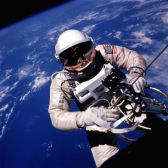Laying a Foundation for Apollo

Laying a Foundation for Apollo
The Space Foundation's commemoration of the Apollo missions continues with this article by Space Foundation Senior Analyst John Holst about a Gemini mission landmark.
Gemini IV: There's a Starman Walking in the Sky
by John Holst, Space Foundation Senior Analyst
Twenty-three minutes outside a capsule in microgravity. That's how long U.S. astronaut Edward White floated in space in June 1965, a first for himself and for NASA.
White was one of a two-man crew for NASA's Gemini IV mission, the second manned mission of the Gemini program. His crewmate, James McDivitt, piloted the Gemini IV capsule, maintained communications with the Capsule Communicator (CAPCOM) on the ground, and took pictures of White while White conducted his extravehicular activity (EVA) or spacewalk. White maneuvered with a hand-held gun that used jets of oxygen to move him around. The gun had about three minutes worth of maneuvering fuel, after which White relied on his tether to the Gemini capsule to move himself around.
NASA wanted to find out how well an astronaut could function in a suit in a depressurized and microgravity space environment. White's spacewalk proved that a human could function and move about outside of the capsule. The lessons learned from his walk were applied not only to the upcoming Apollo missions, but also to humans on the International Space Station who conduct maintenance outside of the station's confines. Spacewalks outside the ISS are typically much longer than 23 minutes, lasting five to eight hours.
The spacewalk was one of many objectives to be accomplished during the Gemini IV mission. The length of the mission itself, four days, was also a first for the Gemini program. Information gained from Gemini's missions helped NASA understand how staying a long time in space might impact astronauts during longer missions for Apollo.
During the mission, before White's spacewalk, the crew also attempted to rendezvous with their second-stage booster. They chased the booster for a few hours before being told to abort that particular objective due to fuel consumption concerns. Because of this attempt, NASA and its astronauts found there was more to learn about orbital mechanics and bodies in motion, adding new data to their books for the success of future rendezvous missions. The Gemini missions were important as NASA experimented with and implemented procedures for the planned Apollo mission rendezvous of the lunar and command modules while circling the Moon.
White wasn't the first human to perform a spacewalk. That honor goes to Soviet cosmonaut Alexei Leonov. He performed a ten-minute EVA three months before White stepped out into space. But both White and Leonov were pioneers in moving about outside a relatively safe vehicle in space, an activity which is nearly routine today for those aboard the ISS. In fact, the record for the longest aggregated amount of time outside in space exceeds three days. The current record-holder? Anatoly Solvyev, a Russian cosmonaut. Just one of the many starmen walking in the sky, 'cause they know it's all worthwhile.
